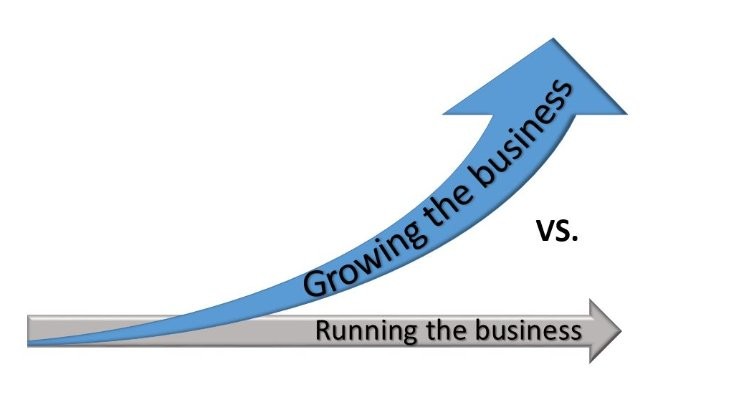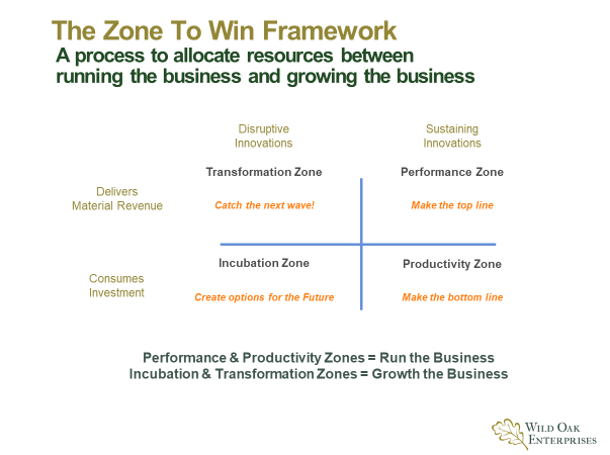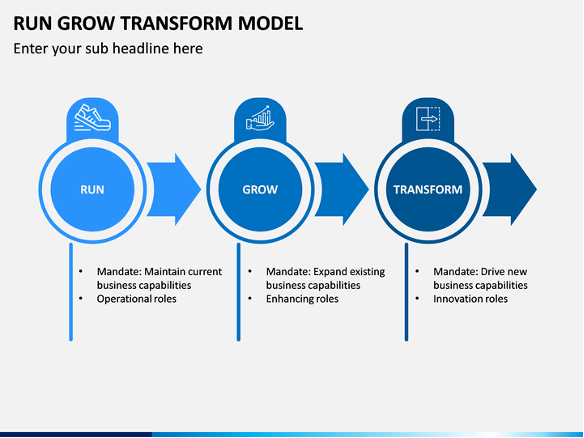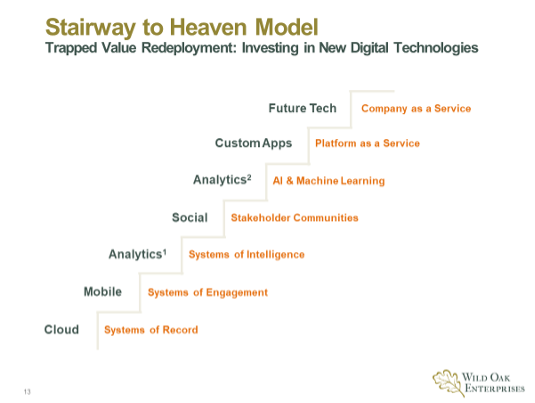
July 26, 2023
In the digital world,
IT is about growing the business not just running the business

What percent of your company’s IT budget and resources are allocated to growing the business?
While we are well into the second decade of digital transformation, it is alarming to see how many companies still allocate the majority of their IT resources and budget to running their business rather than growing their business. As you know, I have strongly advocated for the evolution of IT from a cost center support function to a profit engine that directly contributes to the generation of new revenues, margins, and profits.
In working with a number of CIOs and their C-Suite colleagues to achieve that outcome, I have utilized our 4 Zones model shown on the slide below. It has served as a very clear and effective framework to segment and document how IT currently allocates its resources and budget.

Current budget and resource allocation priorities

IDC’s 2023 State of the CIO survey asked 837 IT leaders and 201 line-of-business (LOB) participants to list the top priorities driving their current resource and budget allocation decisions. I have indicated the zone for each priority:
| 1. Increasing operational efficiency: 45% | Productivity Zone |
| 2. Increasing cybersecurity protections: 44% | Productivity Zone |
| 3. Transforming existing business processes: 38% | Productivity Zone |
| 4. Improving the customer experience: 36% | Performance Zone |
| 5. Improving profitability: 27% | Performance Zone |
| 6. Increasing employee productivity: 25% | Productivity Zone |
| 7. New product development: 22% | Incubation Zone |
| 8. Increasing topline revenue: 20% | Performance Zone |
| 9. Developing new digital revenue streams: 19% | Incubation Zone |
| 10. Optimizing the employee experience: 19% | Productivity Zone |
| 11. Enhancing hybrid work technologies: 18% | Productivity Zone |
| 12. Improving talent acquisition & retention: 17% | Productivity Zone |
| 13. Meeting compliance requirements: 16% | Productivity Zone |
| 14. Monetizing company data: 14% | Incubation Zone |
| 15. Adhering to ESG standards: 11% | Productivity Zone |
Total allocations by Zone:
| Productivity Zone | 9 |
| Performance Zone | 3 |
| Incubation Zone | 3 |
| Transformation Zone | 0 |
The results document that there is still a significant overweighting of budget and resource allocation to running the business rather than growing the business. That doesn’t diminish the importance of many of those run-the-business priorities, but it does suggest that most companies are still not leveraging the plethora of new digital technologies to their competitive advantage.
3 step program to shift resources & budget from run the business to grow the business

Step One: Change the “80% run – 20% grow” resource and budget allocation equation

Early adopters of the 4 Zones model have started by documenting the allocation of their resources and budgets into the four zones as follows:
- % of IT resources & budget allocated to maintaining systems of record
- Productivity Zone – Run the Business
- % of resources & budget allocated to creating & deploying systems of engagement and systems of intelligence
- Performance Zone – Run the Business
- % of resources & budget allocated to identifying, testing, and validating new technologies
- Incubation Zone – Grow the Business
- % of resources & budget allocated to new businesses or acquisitions
- Transformation Zone – Grow the Business
Early adopters have then utilized our trapped value recovery and redeployment process to shift resources and budget from low value, run the business functions to high value, change the business functions by:
- Modernizing, consolidating, outsourcing, or retiring systems of record
- Redeploying resources and budget to develop and deliver new systems of engagement and systems of intelligence
- Shifting from an “80% run-20% grow” to a “40% run-60% grow” allocation equation
Step Two: Redeploy IT resources & budget in new digital technologies
Many companies struggle on deciding which new digital technologies to invest in that best enable the competitive performance of their businesses. The stairway to heaven model below has provided a foundational framework and step by step path forward for making these decisions. It has been very helpful in preventing companies from wasting resources and budgets chasing the next bright, shinny, digital technology object.

Investing in new digital technologies is a building process where the early stages on the bottom of the stairway have to be in place before the later stages can be successfully deployed. In all cases, when deciding whether or not to invest in a new digital technology, the core decision making question you must ask each and every time is “to what end?” If you can’t clearly define and agree upon the critical business outcome the digital technology will enable you are not ready to invest in it yet.
Step Three: Increase the operating performance of the company’s business units
In order to demonstrate how digital technologies can directly increase revenues, margins, and profits, CIOs and their senior leadership teams have used the 4 Zones framework to align future IT investments with critical business outcomes. In collaboration with their internal business partners, they have constructed an IT Collaborative Investment Portfolio which allowed them to reach mutual agreement on how to segment and prioritize multiple IT investments by zone.
They start this collaborative dialogue by asking their internal business stakeholders the following questions:
- What is currently making it difficult for you and your team to achieve your desired business outcomes?
- What can IT do to better enable your critical business capabilities?
- What new products and services are our customers asking for?
- What new digital technologies could disrupt our current customer relationships?
Armed with the answers to these questions, they can begin to talk through multiple investment options and collectively agree on those that will directly impact the desired outcomes they all want to achieve.
Evolving IT from a cost center to a profit engine is not an easy task. It requires:
- Strong leadership from the CIO and the IT senior leadership team
- The utilization of a solid strategic framework and operational transformation toolset
- A commitment to redeploy scarce resources and budget from low value, run the business functions to high value, grow the business functions
- Alignment of future IT investment priorities with critical grow the business priorities
- Tangible uses cases of technology’s ability to directly increase revenues, margins & profits
- A concentrated communication program to position IT as an investment not a cost
The good news is that the work I’ve done with early adopter CIOs and their senior leadership teams utilizing this approach has resulted in them being able to make significant resource and budget allocation shifts from running the business to growing the business.
If this is a journey you want to undertake, I’d welcome the opportunity to discuss how we can put this approach to work for you and your leadership team.
As always, I am interested in your comments, feedback and perspectives on the ideas put forth in this blog. Please e-mail them to me on linkedin. And, if this content could be useful to someone you know please share it here:



